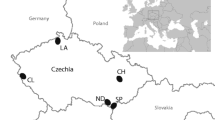Summary
At a newly occupied pond, beavers preferentially felled aspen smaller than 7.5 cm in diameter and selected against larger size classes. After one year of cutting, 10% of the aspen had been cut and 14% of the living aspen exhibited the juvenile growth form. A phenolic compound which may act as a deterrent to beavers was found in low concentrations in aspen bark, and there was no significant regression of relative concentration of this compound on tree diameter. At a pond which had been intermittently occupied by beavers for over 20 years, beavers selected against aspen smaller than 4.5 cm in diameter, and selected in favor of aspen larger than 19.5 cm in diameter. After more than 28 years of cutting at this site, 51% of the aspen had been cut and 49% of the living aspen were juvenileform. The phenolic compound was found in significantly higher concentrations in aspen bark than at the newly occupied site, and there was a significant negative regression of relative concentration on tree diameter. The results of this study show that responses to browsing by trees place constraints on the predictive value of standard energy-based optimal foraging models, and limitations on the use of such models. Future models should attempt to account for inducible responses of plants to damage and increases in concentrations of secondary metabolites through time.
Similar content being viewed by others
References
Aldous SE (1938) Beaver food utilization studies. J Wildl Mgmt 2:215–222
Belovsky GE (1981) Food plant selection by a generalist herbivore: the moose. Ecology 62:1020–1030
Belovsky GE (1984a) Summer diet optimization by beaver. Am Mid Nat 111:209–222
Belovsky GE (1984b) Herbivore foraging: a comparative test of three models. Am Nat 124:97–115
Bryant JP (1981) Phytochemical deterrence of snowshoe hare browsing by adventitious shoots of four Alaskan trees. Science 213:889–890
Bryant JP, Kuropat PJ (1980) Selection of winter forage by subarctic browsing vertebrates: the role of plant chemistry. Ann Rev Ecol Syst 11:261–285
Bryant JP, Wieland GD, Clausen T, Kuropat P (1985) Interactions of snowshoe hare and feltleaf willow in Alaska. Ecology 60:1564–1573
Busher PE (1980) The population dynamics and behavior of beavers in the Sierra Nevada. PhD diss, University of Nevada, Reno, Reno Nevada, xii + 147 pp
Busher PE (1987) Population parameters and family composition of beaver in California. J Mamm 68:860–864
Carlsson A (1983) Maximizing energy delivery to dependent young: a field experiment with red-backed shrikes (Lanius cullurio). J Anim Ecol 52:697–704
Carlsson A, Moreno J (1985) Central place foraging in wheatears (Oenanthe oenanthe L): foraging itineraries when feeding nestlings. Behav Ecol Sociobiol 16:307–316
Chesson J (1983) The estimation and analysis of preference and its relationship to foraging models. Ecology 64:1297–1304
clausen TP, Reichardt PB, Bryant JP (1986) Pinosylvin and pinosylvin methyl ether as feeding deterrents in green alder. J Chem Ecol 12:2117–2131
Davidson DW (1978) Experimental tests of optimal diet in two social insects. Behav Ecol Sociobiol 4:35–41
Freeland WJ, Janzen DH (1974) Strategies in herbivory by mammals: the role of plant secondary compounds. Am Nat 108:269–289
Hall JG (1960) Willow and aspen in the ecology of beaver on Sagehen Creek, California. Ecology 41:484–494
Janzen DH, Martin PS (1982) Neotropical anachronisms: the fruits the Gomphotheres ate. Science 215:19–27
Jenkins SH (1979) Seasonal and year-to-year differences in food selection by beavers. Oecologia (Berl) 44:112–116
Jenkins SH (1980) A size-distance relation in food selection by beavers. Ecology 61:740–746
Klein DR (1977) Winter food preference of snowshoe hares (Lepus americanus) in interior Alaska. Proc Int Congr Game Biol 13:266–275
Kramer PJ, Koslowski TT (1979) Physiology of woody plants. Academic Press, New York, New York
Krebs JR, Avery ML (1985) Central place foraging in the European bee-eater, Merops apiaster J Anim Ecol 54:459–472
Lessels CM, Stephens DW (1983) Central place foraging: single prey loaders again. Anim Behav 31:238–243
Orians GH, Pearsons NE (1979) On the theory of central place foraging. In: Horn DH, Mitchell R, Stairs G (eds) Analysis of ecological systems. Ohio State Univ Press, Columbus, pp 155–177
McGinley MA, Whitman TG (1985) Central place foraging by beavers (Castor canadensis): a test of foraging predictions and the impact of selective feeding on the growth form of cottonwoods (Populus fremontii). Oecologia (Berl) 66:558–562
Palo TP (1984) Distribution of birch (Betula spp.), willow (Salix spp.), and poplar (Populus spp.) secondary metabolites and their potential role as chemical defense against herbivores. J Chem Ecol 10:499–520
Pinkowski B (1983) Foraging behavior of beavers (Castor canadensis) in North Dakota. J Mamm 64:312–314
Pyke GH, Pulliam HR, Charnov EL (1977) Optimal foraging: a selective review of theory and tests. Quart Rev Biol 52:137–154
Reichardt PB, Bryant JP, Clausen TP, Wieland GD (1984) Defense of winter-dormant Alaska paper birch against snowshoe hares. Oecologia (Berl) 65:58–69
Schoener TW (1979) Generality of the size-distance relation in models of optimal feeding. Am Nat 114:902–914
Sinclair ARE, Krebs CJ, Smith JNM (1982) Diet quality and food limitation in herbivores: the case of snowshoe hare. Canad J Zool 60:889–897
Sinclair ARE, Smith JNM (1984) Do plant secondary compounds determine feeding preferences of snowshoe hares? Oecologia (Berl) 61:403–410
Stegeman LC (1954) The production of aspen and its utilization by beaver on the Huntington Forest. J Wildl Mgmt 18:348–358
Tahvanainen J, Helle E, Julkunen-Titto R, Lavola A (1985) Phenolic compounds of willow bark as deterrents against feeding by mountain hare. Oecologia (Berl) 65:319–323
Author information
Authors and Affiliations
Rights and permissions
About this article
Cite this article
Basey, J.M., Jenkins, S.H. & Busher, P.E. Optimal central-place foraging by beavers: Tree-size selection in relation to defensive chemicals of quaking aspen. Oecologia 76, 278–282 (1988). https://doi.org/10.1007/BF00379963
Received:
Issue Date:
DOI: https://doi.org/10.1007/BF00379963




